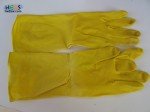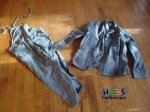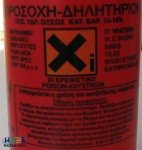![]() The etching is the technique that a strong acid chemical solution "eats" the unprotected copper.
The etching is the technique that a strong acid chemical solution "eats" the unprotected copper.
So the etching method can be used for the production of printed circuit boards (PCB) since acid can be used to remove the unwanted copper from a copper clad.
A nice and easy method in order to make printed circuits at home is to use the so called : "toner transfer method". This method will be discussed in another article.
For now keep in mind that you have a copper clad (fr4) with the circuit "printed" (with toner) on it.
So this printed copper board can be etched with an acid solution called etchant.
This acid solution will eat all the unprotected toner and the remained, protected by the toner, copper will be our final printed circuit.
Before even think to start making an etchant at your home you must pay attention at your safety.
First of all you need :
- Protective glasses
- Latex gloves
- Old clothes with long sleeves
- An open place (balcony, roof, garden etc...)
Do not start producing etchant without these requirements.
Any etchant is strong acid, very corrosive and hazard.
Safety first.
The Ferric Chloride (FeCl3) is a common etchant. The FeCl3 by itself is no big environmental problem but when is used as etchant reacts and gives CuCl which cannot be deposited legally. Another problem with Ferric Chloride is that needs to be heated (40C) in order to react faster with the copper. Other than that FeCl3 is not cheap and does not last forever so you have to keep buying this stuff with no legal at least way to get rid of it after it's use.
So instead using the traditional Ferric Chloride (FeCl3) we will use a cheaper and more environmental friendly etchant.
We will use 170gr hydrochloric acid (HCl) 15%w/w with 200gr of hydrogen peroxide (H202) at 3%w/w
That's will be our etchant.
The hydrochloric acid can be found easily at any supermarket and the hydrogen peroxide can be found at any pharmachy.
Pay attention at the concentrations.
So what we will need is :
- Protective glasses
- Latex gloves
- Old clothes with long sleeves
- An open place (balcony, roof, garden etc...)
- A bottle of hydrochloric acid (450 ml) at 15%w/w
- A couple of bottles (200gr each) of hydrogen peroxide at 3%w/w
- An empty coca cola plastic bottle 500ml with his plastic cap
- A dedicated funnel
- A digital scale
Below are some HCl solution photos :
As you may notice this particular HCl solution is a 450 ml solution concentrated 15% w/w
Some hydrogen peroxide are shown below :
From the photos you can see a 200 gr container Hydrogen peroxide solution concentrated 3%w/w
It is time to mix the two solutions into our coca cola plastic bottle.
Do not use a simple water plastic bottle since gas will be produced from the reaction of the two solutions.
Do not use a metalic container in order to mix these two solutions
This procedure is extremely dangerous.
Proceed with calm and attention.
- Wear your safety gloves and glasses
- Wear your old work clothes with long sleeves
- Open the empty coca cola plastic bottle. Make sure that the cap closes well.
- After inspecting the plastic bottle wash it well with water.
- Put the funnel on top of it
- Fill the plastic bottle with 200 gr of Hydrogen peroxide 3%w/w (in our case we empty the hydrogen peroxide bottle)
- Now using a digital scale fill with 170gr the coca cola bottle with hydrocloric acid (HCl) 15%w/w
- Remove the funnel and close well the bottle.
- Put a warning on the bottle and store it on a secure place
- Your transparent etchant is ready
Below we can see the etchant solution (empty and full bottle)
As you can see the initial etch solution is transparent. This is a bigger reason to put a warning sign on the bottle.












